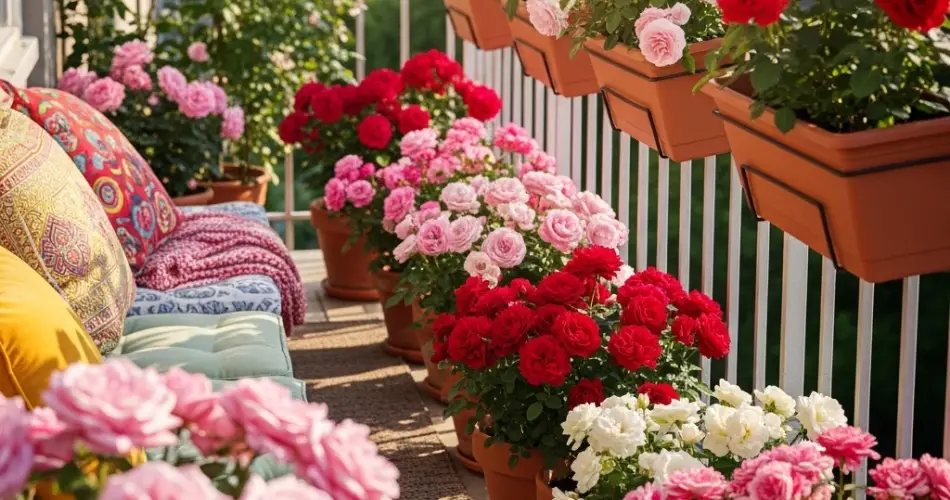Roses are often thought of as garden staples, thriving in large beds and sprawling landscapes. However, with the right approach, you can successfully grow beautiful roses in pots—even on a small balcony. Whether you’re short on space or simply want to enjoy the charm of roses up close, container growing is a practical and rewarding solution.
This guide will walk you through everything you need to know to grow healthy, blooming roses in pots on your balcony.
Why Grow Roses in Pots?
Container gardening offers flexibility and control. Growing roses in pots allows you to:
-
Optimize sunlight by moving the pot throughout the day
-
Control soil quality and drainage
-
Grow roses even in small spaces like balconies or patios
-
Manage pests and diseases more easily
With proper care, potted roses can be just as vibrant and long-lasting as those planted in the ground.
1. Choose the Right Rose Variety
Not all roses are suited for containers. Choose compact or patio-friendly varieties that won’t outgrow their pots too quickly. Ideal options include:
-
Miniature roses: Small, bushy plants with petite flowers; perfect for tight spaces.
-
Floribundas: Bushy and compact, with continuous blooms throughout the season.
-
Groundcover roses: Low-growing varieties that adapt well to pots.
-
Dwarf hybrid teas or patio roses: Bred specifically for containers, offering traditional rose form in a manageable size.
-
Climbing roses (with support): Suitable for larger balconies with vertical space; use a trellis or railing for support.
Check the plant tag or description to confirm it’s suitable for container growing.
2. Select the Right Container
The pot you choose plays a crucial role in your rose’s health. Keep these factors in mind:
-
Size: Use a pot at least 12–15 inches deep and wide. Larger is better for root development and moisture retention.
-
Material: Terracotta, ceramic, wood, or heavy-duty plastic pots are all good options. Avoid thin plastic pots that can overheat or tip over easily.
-
Drainage: Make sure the pot has adequate drainage holes. Place a saucer underneath if needed, but never let water pool at the base.
3. Use Quality Potting Mix
Roses prefer rich, well-draining soil. For containers, use:
-
A high-quality potting mix (not garden soil)
-
A blend that retains moisture but drains well
-
Optional: mix in compost, aged manure, or slow-release organic fertilizer for added nutrients
Avoid soil that becomes compacted or soggy over time.
4. Position for Maximum Sunlight
Roses need at least 6 hours of direct sunlight daily to bloom their best. On a balcony:
-
Place pots where they’ll receive morning and early afternoon sun
-
Avoid shaded corners or areas blocked by walls or railings
-
Rotate pots occasionally to ensure even light exposure
If your balcony faces north or receives limited sunlight, consider using grow lights to supplement natural light.
5. Watering and Moisture Management
Container-grown roses dry out faster than those in the ground, especially in hot weather. Watering is critical.
Watering tips:
-
Water deeply when the top inch of soil feels dry
-
Ensure water flows through the drainage holes
-
Avoid letting the pot sit in standing water
-
In summer, you may need to water every day; reduce frequency in cooler months
Mulching the soil surface with bark, straw, or compost helps retain moisture and regulate temperature.
6. Feeding Your Balcony Roses
Roses are heavy feeders and need regular fertilization for strong growth and blooms.
Fertilizing schedule:
-
Use a balanced liquid fertilizer (like 10-10-10) every 2–3 weeks during the growing season
-
Alternatively, apply a slow-release granular fertilizer every 6–8 weeks
-
Stop feeding 6 weeks before your region’s first frost to allow the plant to harden off
Choose fertilizers specifically designed for roses if possible.
7. Pruning and Deadheading
Regular pruning helps shape your plant and encourages more flowers.
-
Deadhead faded blooms to encourage continuous blooming
-
Remove any yellowing or damaged leaves to maintain plant health
-
In late winter or early spring, prune back stems to encourage new growth
For climbing roses, guide and tie long canes to a trellis or support to promote upward growth.
8. Pest and Disease Control
Roses in containers are generally less prone to problems, but still watch out for:
-
Aphids, spider mites, and whiteflies: treat with insecticidal soap or neem oil
-
Black spot, powdery mildew, and rust: prevent with good air circulation and avoid overhead watering
Inspect your plant regularly and act early at the first sign of trouble.
9. Winter Protection
If you live in a region with cold winters, potted roses may need extra protection:
-
Move pots to a sheltered area, like a garage or covered porch
-
Wrap containers with burlap or insulating material
-
Water sparingly during dormancy—just enough to prevent the soil from drying out completely
Alternatively, bring pots indoors temporarily if needed.
Final Thoughts
Growing roses in pots on your balcony is a fulfilling way to bring fragrance, color, and life to a small space. With the right variety, soil, container, and care routine, your potted roses can bloom beautifully throughout the growing season. Whether you have a small city balcony or a sunny terrace, container-grown roses can transform it into a mini rose garden that brings joy all year round.



